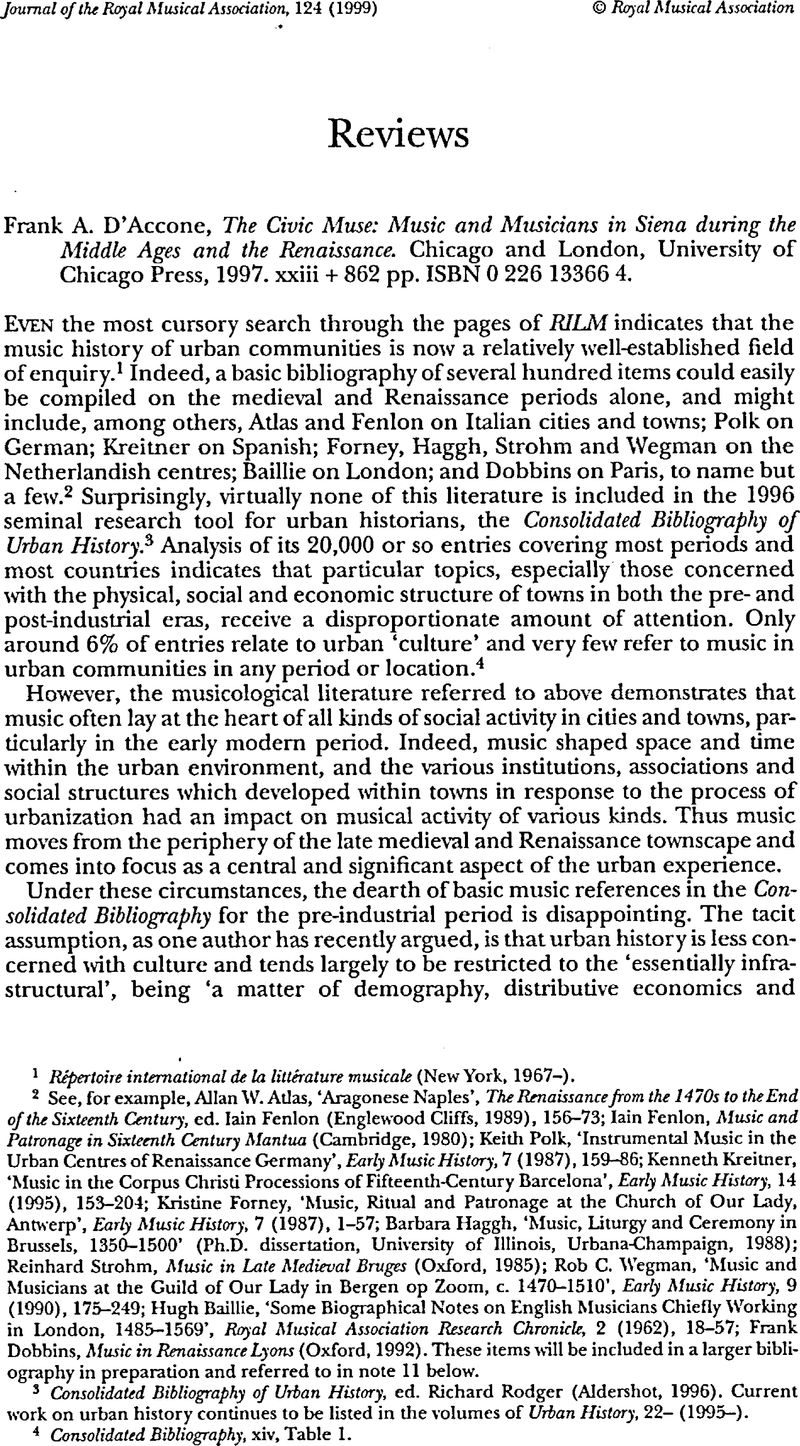No CrossRef data available.
Published online by Cambridge University Press: 01 January 2020

1 Répertoire international de la littérature musicale (New York, 1967–).Google Scholar
2 See, for example, Atlas, Allan W., ‘Aragonese Naples’, The Renaissance from the 1470s to the End of the Sixteenth Century, ed. Iain Fenlon (Englewood Cliffs, 1989), 156–73; Iain Fenlon, Music and Patronage in Sixteenth Century Mantua (Cambridge, 1980); Keith Polk, ‘Instrumental Music in the Urban Centres of Renaissance Germany’, Early Music History, 7 (1987), 159-86; Kenneth Kreitner, ‘Music in the Corpus Christi Processions of Fifteenth-Century Barcelona’, Early Music History, 14 (1995), 153-204; Kristine Forney, ‘Music, Ritual and Patronage at the Church of Our Lady, Antwerp’, Early Music History, 7 (1987), 1-57; Barbara Haggh, ‘Music, Liturgy and Ceremony in Brussels, 1350-1500’ (Ph.D. dissertation, University of Illinois, Urbana-Champaign, 1988); Reinhard Strohm, Music in Late Medieval Bruges (Oxford, 1985); Rob C. Wegman, ‘Music and Musicians at the Guild of Our Lady in Bergen op Zoom, c. 1470-1510’, Early Music History, 9 (1990), 175-249; Hugh Baillie, ‘Some Biographical Notes on English Musicians Chiefly Working in London, 1485-1569’, Royal Musical Association Research Chronicle, 2 (1962), 18-57; Frank Dobbins, Music in Renaissance Lyons (Oxford, 1992). These items will be included in a larger bibliography in preparation and referred to in note 11 below.Google Scholar
3 Consolidated Bibliography of Urban History, ed. Richard Rodger (Aldershot, 1996). Current work on urban history continues to be listed in the volumes of Urban History, 22– (1995–).Google Scholar
4 Consolidated Bibliography, xiv, Table 1.Google Scholar
5 The Reformation in English Towns, 1500-1640, ed. Patrick Collinson and John Craig (Basingstoke, 1998), 3.Google Scholar
6 Cannadine, David, ‘Urban History in the UK: The Dyos Phenomenon and After’, Exploring the Urban Past: Essays in Urban History by H. J. Dyos, ed. David Cannadine and David Reeder (Cambridge, 1982), 203–22 (pp. 207-8); Harold James Dyos, ‘Urbanity and Suburbanity’, ibid., 19-36 (p. 31).Google Scholar
7 Cannadine, , ‘Urban History’, 208.Google Scholar
8 Dyos, Harold James, ‘Editorial’, Urban History Yearbook (1977), 3–5 (p. 4).Google Scholar
9 Rodger, Richard, ‘Urban History. Prospect and Retrospect’, Urban History, 19 (1992), 1–22 (pp. 4, 7, 22).CrossRefGoogle Scholar
10 Dyos, , ‘Urbanity and Suburbanity’, 36.Google Scholar
11 In an attempt to fill the present musical lacunae in the Consolidated Bibliography, a bibliography is currently being prepared by the present author for publication: ‘Music and Musicians in Pre-Industrial Urban Societies to c.1600: A Preliminary Bibliography'.Google Scholar
12 Wathey, Andrew, Music in the Royal and Noble Households of Late Medieval England (New York, 1989), introduction; Models of Musical Analysis: Music before 1600, ed. Mark Everist (Oxford, 1992), vii-xi.Google Scholar
13 It is the purpose of a forthcoming book of essays, edited by the present author, to demonstrate how musical questions are of relevance to urban history: Music and Musicians in Urban Societies: Culture, Community and Change in Renaissance Europe (Cambridge).Google Scholar
14 D'Accone, The Civic Muse, 164-6, 243, 573. Further references to this work will be by page number only.Google Scholar
15 Strohm, Reinhard, ‘European Politics and the Distribution of Music in the Early Fifteenth Century’, Early Music History, 1 (1981), 305–23.CrossRefGoogle Scholar
16 For more on city-states and their government see Mackenney, Richard, The City-State, 1500-1700: Republican Liberty in an Age of Princely Power (London, 1989); The City State in Five Cultures, ed. Robert Griffeth and Carol Thomas (Oxford, 1981).Google Scholar
17 For more details of the historical events leading up to Siena's loss of independence see Hook, Judith, ‘The Fall of Siena’, History Today, 23 (1973), 105–15.Google Scholar
18 The author is at pains to point out, though, that individual administrators such as Alberto Aringhieri in the late fifteenth century were in a position to formulate policies intended to counter this instability of the cathedral personnel (pp. 224ff.).Google Scholar
19 For more on this topic, see Reynolds, Christopher, ‘Southern Pull or Northern Push? Motives for Migration in the Renaissance’, Trasmissione e recezione delle forme di cultura musicale: Atti del XIV Congresso della Società Intemazionale di Musicologia (Bologna 1987), ed. Lorenzo Bianconi et al. (Turin, 1990), 155–61; Barbara Haggh, ‘Itinerancy to Residency: Professional Careers and Performance Practices in 15th-Century Sacred Music’, Early Music, 17 (1989), 358-66.Google Scholar
20 See also Frank D'Accone, ‘The Sienese Rhymed Office for the Feast of Sant’ Ansano’, L'Ars nova italiana del trecento, 6 (1992), 21–40.Google Scholar
21 Useful historical maps of Renaissance Italy occur in Geoffrey Barraclough, The Times Concise Atlas of World History (5th edn, London, 1994), 73; Herman Kinder and Werner Hilgemann, The Penguin Atlas of World History, i: From the Beginning to the Eve of the French Revolution, trans. Ernest August Menze (repr. Harmondsworth, 1985). A contemporary view taken from Orlando Malavolti's Dell'historia de Siena (Venice, 1599) is reproduced in Judith Hook, Siena: A City and its History (London, 1979), between pp. 4 and 5.Google Scholar
22 Fiona Kisby, ‘The Music and Musicians of Early-Tudor Westminster’, Early Music, 23 (1995), 223–41; eadem, ‘Royal Minstrels in the City and Suburbs of Early-Tudor London: Professional Activities and Private Interests’, Early Music, 25 (1997), 199-221; David Skinner, ‘At the Mynde of Nicholas Ludford’, Early Music, 22 (1994), 393-413; Andrew Wathey, ‘Editorial’, Early Music, 25 (1997), 180-5.Google Scholar
23 Hook, , Siena, 10-11.Google Scholar